1.
Beefsteak Fungus (
Fistulina hepatica).
-
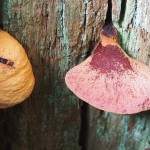
- 1. Beefsteak Fungus
-
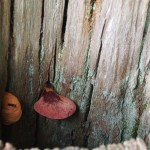
- 1. Beefsteak Fungus
-
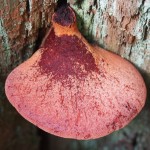
- 1. Beefsteak Fungus
-
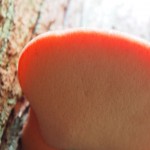
- 1. Beefsteak Fungus
-
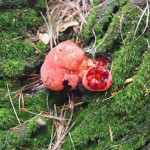
- 1. Beefsteak Fungus
Growing inside old stump. Bracket 10cm across. Scarlet pink with white underside. Very pink and pretty. Not sure if this really is Beefsteak Fungus but I can't find anything else similar. Happening to be growing next to a yellow fungal blob which was an interesting colour clash. Also, a few hundred yards away was another small red blobby thing. Could it be a very immature version of the the same thing? ID is best guess.
2. Unidentified.
-
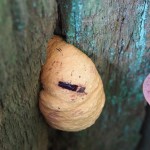
- 2. Unidentified
Growing inside old stump. one. Yellow lump - presumably immature. Surface very sticky to touch.
3.
Type of Russula.
-
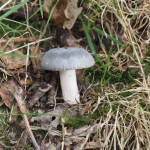
- 3. Type of Russula
-
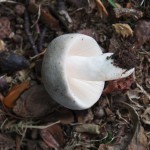
- 3. Type of Russula
-
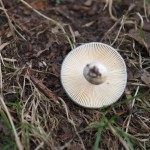
- 3. Type of Russula
Growing under oak. Several scattered around. Cap 3cm. No smell. Taste mild. Sporeprint white.
4.
Spectacular Rustgill (
Gymnopilus junonius).
-
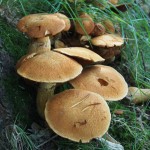
- 4. Spectacular Rustgill
-
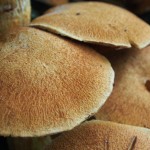
- 4. Spectacular Rustgill
-
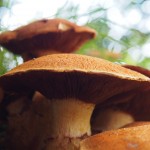
- 4. Spectacular Rustgill
-
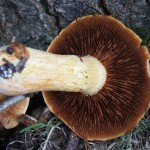
- 4. Spectacular Rustgill
-
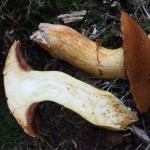
- 4. Spectacular Rustgill
-
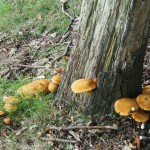
- 4. Spectacular Rustgill
-
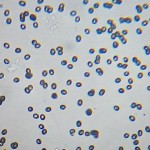
- 4. Spectacular Rustgill
Growing on base of oak stump. Large clusters. Cap 3-9cm. No smell. Firm tough flesh. Spores 6-7.5µ x 5-6µ.
5.
Common Earthball (
Scleroderma citrinum).
-
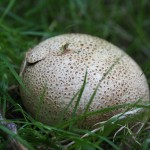
- 5. Common Earthball
-
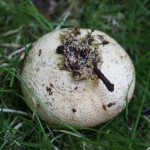
- 5. Common Earthball
-
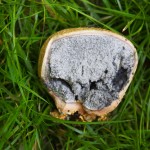
- 5. Common Earthball
Growing in mixed woods; oak and birch. Lots everywhere. 3-10cm. Mild fungus smell. Some of the many earthballs could have been other species, but the large size is indicative of Common Earthball. ID is very likely.
6.
Mild Milkcap (
Lactarius subdulcis).
-
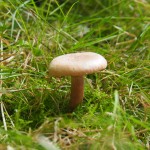
- 6. Mild Milkcap
-

- 6. Mild Milkcap
Growing amongst moss/grass under oak. Cap 3cm. Milk has no heat, but perhaps a bit nutty. ID is very likely. Sporeprint white.
7.
Hen of the Woods (
Grifola frondosa).
-
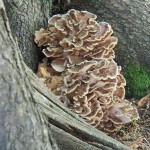
- 7. Hen of the Woods
-
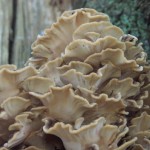
- 7. Hen of the Woods
-
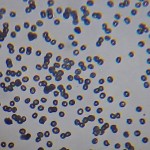
- 7. Hen of the Woods
Growing at base of sweet chestnut stump. Lobes up to 8cm across, whole body 25cm across. Smell fungusy. Spores 6.5-8µ x 5.5-7µ.
9.
Phyllotopsis nidulans.
-
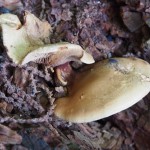
- 9. Phyllotopsis nidulans
-
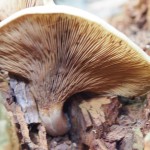
- 9. Phyllotopsis nidulans
-
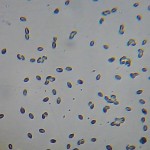
- 9. Phyllotopsis nidulans
Growing on sweet chestnut stump. Two fans. Fan 8-10cm. No smell. ID is almost sure. Sporeprint orangey brown. Spores 5.5-7.5µ x 3.5-5µ.
10.
Type of Webcap.
-
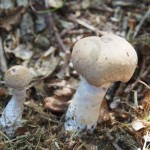
- 10. Type of Webcap
-
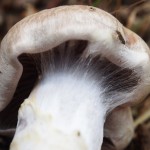
- 10. Type of Webcap
-
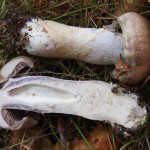
- 10. Type of Webcap
-
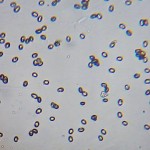
- 10. Type of Webcap
Growing in leaf litter under oak. Group of 4. Cap up to 4cm, but some very small. Smell indistinct. Spores 6-8µ x 4.5-6µ.
11.
Purple Russula (
Russula atropurpurea).
-
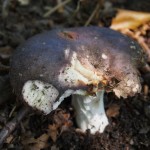
- 11. Purple Russula
-
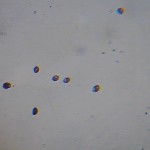
- 11. Purple Russula
Growing under oak. Lots scattered. Cap up to 8cm across. Little smell. Little taste - perhaps slight hint of heat. Cap nearly half peeling. ID is fairly likely. Sporeprint white. Spores 7-9µ x 5-6.5µ.
12. Unidentified.
-
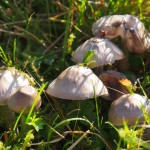
- 12. Unidentified
-
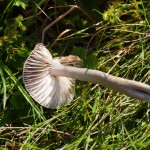
- 12. Unidentified
-
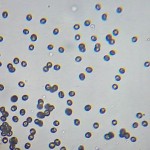
- 12. Unidentified
Growing in grass. Cluster. Cap 1.5-3cm. Smell faint. Some with umbo. Sporeprint whitish but not enough to be specific. Spores 6.5-7.5µ x 5-7µ.
13.
Parasol (
Macrolepiota procera).
-
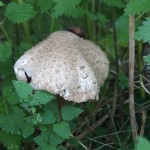
- 13. Parasol
-
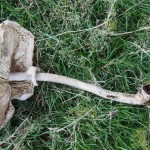
- 13. Parasol
Growing under hawthorn. Three. Cap 18cm, 27cm high. Old specimens.
14.
Golden Waxcap (
Hygrocybe chlorophana).
-
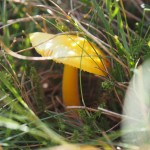
- 14. Golden Waxcap
-
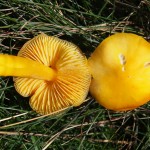
- 14. Golden Waxcap
Growing in long grass. Group of 5. cap 3.5cm, 6cm high. No smell. ID is very likely. Sporeprint white.
15.
Birch Milkcap (
Lactarius tabidus).
-
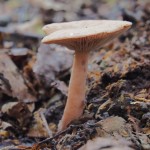
- 15. Birch Milkcap
-
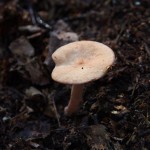
- 15. Birch Milkcap
-
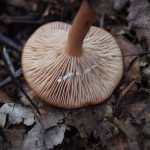
- 15. Birch Milkcap
-
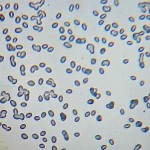
- 15. Birch Milkcap
Growing under birch. Several scattered around. Cap 3cm. Milk tastes dry and then bitter. Small darker umbo on immature ones. Colour was pale orange - I think the photos may be a bit misleading. ID is almost sure. Sporeprint white. Spores 6.5-8.5µ x 4.5-6.5µ.
16.
Type of Milkcap.
-
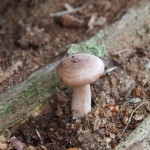
- 16. Type of Milkcap
-
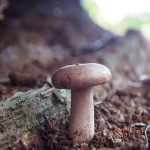
- 16. Type of Milkcap
-
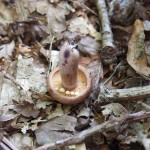
- 16. Type of Milkcap
-

- 16. Type of Milkcap
Appears to be growing on debris on rotting log. One. Cap 2cm but probably immature. Faint smell. Milk has no flavour. Not easy to identify as only one small specimen. Strange that it's growing on a log (or appears to be) - milkcaps don't do that. Spores 6-8µ x 5-7µ.
17.
Scarletina Bolete (
Boletus luridiformis).
-
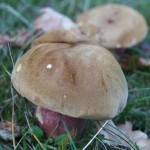
- 17. Scarletina Bolete
-
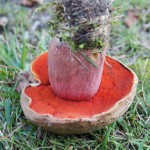
- 17. Scarletina Bolete
-
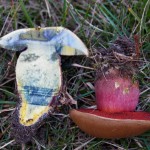
- 17. Scarletina Bolete
Growing in wide grassy trackway about 30 foot from very large oak. Two. Cap 5-6cm. Faint smell. Photos make the pores look orange/red but really they were more browny. Flesh immediately bruising dark blue. A strikingly attractive mushroom! ID is almost sure.



















































